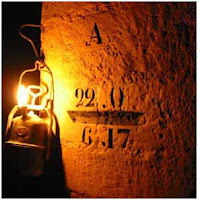An Adventure History of Paris
Consider this an entirely unorthodox guidebook through the crooked streets and tumultuous times of Paris. Robb, as expert as one can be without actually being Parisian, uncovers and shares fleeting tales of famous moments in the City of Lights.
It is rather like finding a train ticket or a receipt and discovering an unknown afternoon. He leads off with a somewhat innocuous story of Napoleon visiting the city (the Palais-Royal in particular) as a young man. From a diary entry, the reader sees a generous and impressionable man — not a fearless conqueror.
 |
| A sophisticated underground system |
Robb continues to reanimate voices through the centuries. Marie Antoinette is captured only because she became lost during her escape attempt. M. Guillaumot literally keeps Paris from collapsing by shoring up old mining quarries and tunnels — then finds a new use for his underground city. The real, vengeful and masterful Comte de Monte Cristo is uncovered. The romantic criminal-turned-detective Vidocq and the devastating life behind La Boheme. There is a story of a small building in Marville that escaped numerous wrecking balls. The photographs of it over the years show the lives it has held. It is a study of which Walter Benjamin and Roland Barthes would be proud. Zola and Proust weave in amongst the crowds in the early days of the Eiffel Tower and the Metro – landmarks in their own right. An alchemist takes clues from the facade of Notre Dame and an exuberant Hitler goes on an eerie tour of the city he has obsessed over.
 |
| A famous Metro sign |
The book slumps in the middle. The chapters “Occupation” and “Lovers of Saint-Germain Des Pres” do not hold up nearly as well. Robb uses various storytelling techniques throughout the book, all in an attempt to enhance each tale. Yet the distant, impressionist portrait of the lives of children during the war doesn’t carry the weight it deserves. The existential chapter is written in screenplay form (Godard-esque, perhaps?) but it is barely readable. Thankfully, Robb returns to more approachable and appropriate styles of the remainder of the book. (Sadly, he skips the surrealists and the street photographers of the 1920s. Perhaps he feared too much had been written on them already).
These are postcards; small tales, yet ones you can’t believe you’d never heard. It underscores the importance of archives, history-gathering, and storytelling in our own time. It is not the streets and buildings that make a city — it is what happens within (and under) them. The foundations of predecessors determine as much as a cornerstone.
Many thanks to the folks at WW Norton for the review copy.
___________
Hardcover – April 2010 ISBN 978-0-393-06724-8 6.5 × 9.5 in / 496 pages

